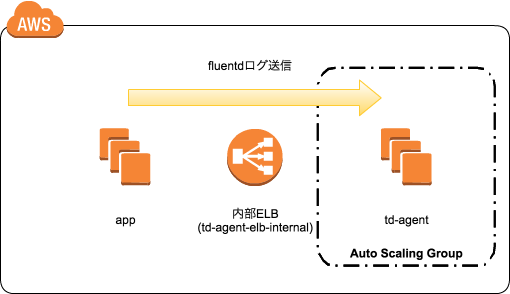##検証を思いついた経緯
- appサーバ側のforward設定で複数の
<server>タグを管理したくない - td-agentのconfigに影響されず、AWSメンテナンスやインスタンス障害の対応を行いたい
- アプリケーションが乗るappサーバと違い、td-agentクラスタは純粋に負荷を見極めやすいため、AutoScalingに適している
- fluentdのコミュニティで「TCPロードバランシングはユーザ側で試して欲しい」という状況で更新が止まっていた
https://groups.google.com/forum/#!topic/fluentd/3ZuG_1dPovE
##td-agentクラスタ環境準備
###1.環境構成
今回、VPC,SecutityGroup,AMIの作成方法は割愛。
以下の環境を準備する。
###2.appインスタンスのtd-agent設定
<source>
type forward
</source>
<match *.**>
type copy
<store>
type forward
heartbeat_type tcp
<server>
host td-agent-elb-internal-1234567890.ap-northeast-1.elb.amazonaws.com
port 24224
</server>
</store>
</match>
heartbeat_type tcp ここが今回の一番の肝。
fluentdのハートビートはデフォルトでUDPだが、ELBのListers設定はTCPで行う必要があるため、fluentdのハートビートをTCPで行う。
###3.内部ELB
aws elb create-load-balancer \
--load-balancer-name td-agent-elb-internal \
--listeners Protocol=TCP,LoadBalancerPort=24224,InstanceProtocol=TCP,InstancePort=24224 \
--subnets subnet-aaaaaaaa \
--security-groups sg-bbbbbbbb \
--scheme internal
ELBのLisners設定できるのは、TCP,HTTP,HTTPS,SSLのみ。
Lisners側でtd-agentインスタンスの24224ポートへの連携を設定する。
###4.td-agentインスタンスのtd-agent設定
<source>
type forward
</source>
#下記は環境によって変更する。
<match *.**>
type stdout
</match>
今回の<match *.**>配下はテスト用。
実運用上はここに各種設定を記載する。
###5.AutoScaling
####Launch Configuration
aws autoscaling create-launch-configuration \
--launch-configuration-name fluent-as-configuration \
--image-id ami-cccccccc \
--key-name xxxx \
--security-groups sg-bbbbbbbb \
--instance-type t2.micro \
--associate-public-ip-address
--image-id ami-ccccccccは、td-agentインスタンスのAMIを指定する。
chkconfig --listなどでtd-agentが自動起動することをお忘れなく。
####Auto Scaling Group
aws autoscaling create-auto-scaling-group \
--auto-scaling-group-name fluent-as-group \
--launch-configuration-name fluent-as-configuration \
--min-size 1 \
--max-size 2 \
--desired-capacity 1 \
--availability-zones ap-northeast-1b \
--load-balancer-names td-agent-elb-internal \
--health-check-type EC2 \
--vpc-zone-identifier subnet-aaaaaaaa \
--tags Key=Name,Value=fluent-as
####Scaling Policies
aws autoscaling put-scaling-policy \
--auto-scaling-group-name fluent-as-group \
--policy-name ScaleOut \
--scaling-adjustment 1 \
--adjustment-type ChangeInCapacity
##td-agentクラスタ検証
###1.td-agentクラスタのスケールアウト
テスト用に以下のようにCPU使用率を0%以上になったら、スケールアウトするように設定する

こんな感じで、ELB配下に追加のtd-agentインスタンスが準備される

###2.appインスタンスから、ログを送信
appサーバからfluent-catを使って、td-agentクラスタに1万件のログ送信を試してみた結果は以下の通り
|検証内容|結果|備考|
|:--|:--|:--||
|2台のtd-agentインスタンスをぶら下げる|td-agent1:5,012件
td-agent2:4,988件|
|1台のtd-agentを落として、復帰させる|td-agent1:8,200件
td-agent2:1,800件|障害などでELBのヘルスチェックにひっかかったケース|
|ログ送信中にDesiredCapacityを増やす|td-agent1:326件
td-agent2:351件
td-agent3:9,323件|AutoScalingでインスタンスが増えたケース|
##まとめ
td-agent(fluentd)は、tcpでもロードバランシングしてくれることが確認できた。
今回の検証ではAutoScalingで追加したインスタンスにログ送信が偏ってしまったが、これはELBの振り分けルールによるものと考えられる(新規追加されたインスタンスは、負荷が少ないと認識される?)
ログの欠損もない模様なので、ひとまず実運用に耐えられそうかなと。
